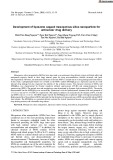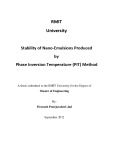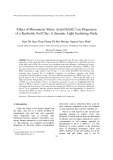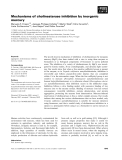
A dynamic light scattering study
-
Mesoporous silica nanoparticles (MSNs) have been used as an anticancer drug delivery system with high safety and entrapment capacity thanks to their large internal space for drug accommodation, durable structure, and good biocompatibility. However, the treatment efficiency of the bare MSNs is limited due to its drug leakage and burst release. In this study, a phospholipid bilayer was covered on the MSNs surface (MSN@Lip) as a liposomal cap that not only reduced drug leakage but also improved the stability of the colloidal system.
 8p
8p  dianmotminh02
dianmotminh02
 03-05-2024
03-05-2024
 8
8
 2
2
 Download
Download
-
This study focuses on the stability of nano-emulsions produced by phase inversion temperature method using n-Decane and n-Dodecane as the dispersed phase and pure water/brine as the aqueous phase (continuous phase). A non-ionic surfactant (Brij 30) was used in the preparation of the nano-emulsions. Three different types salt namely \(NaCl\), \(KCl\) and \(MgC{l_2}\) were used at different concentrations.
 173p
173p  runthenight07
runthenight07
 01-03-2023
01-03-2023
 4
4
 3
3
 Download
Download
-
This study introduced a method to produce a thermosensitive nanocomposite hydrogel (nCur-PG) containing curcumin nanoparticles (nCur) which can overcome the poor dissolution of curcumin. Regarding to the method, a thermo-reversible pluronic F127-grafted gelatin (PG) play a role as surfactant to disperse and protect nanocurcumin from aggregation. The synthetic PG was identified by 1H-NMR. The obtained results via Transmission Electron Microscopy (TEM) and Dynamic Light Scattering (DLS) indicated that the size of nCur was various in the range from 1.5 ± 0.5 to 128 ± 9.
 9p
9p  elandorr
elandorr
 03-12-2019
03-12-2019
 30
30
 1
1
 Download
Download
-
The most effective concentration of MSA was 5 mg L-1 at the pH range of 3.5 to 5 and electrolyte background of 0.01 molc L-1. Out of this pH range or at higher electrolyte backgrounds, clay suspension is more strongly favored or prohibited; the effect of MSA was usually hidden.
 7p
7p  nguyenvanhoangvnu
nguyenvanhoangvnu
 12-06-2017
12-06-2017
 56
56
 2
2
 Download
Download
-
Porcine heart cytoplasmic malate dehydrogenase (s-MDH) is a dimeric protein (2 · 35 kDa). We have studied equilibrium unfolding and refolding of s-MDH using activity assay, fluorescence, far-UV and near-UV circular dichroism (CD) spectroscopy, hydrophobic probe-1-anilino8-napthalene sulfonic acid binding, dynamic light scattering, and chromatographic (HPLC) techniques. The unfolding and refolding transitions are reversible and show the presence of two equilibrium intermediate states.
 11p
11p  system191
system191
 01-06-2013
01-06-2013
 38
38
 4
4
 Download
Download
-
The poorly known mechanism of inhibition of cholinesterases by inorganic mercury (HgCl2) has been studied with a view to using these enzymes as biomarkers or as biological components of biosensors to survey polluted areas. The inhibition of a variety of cholinesterases by HgCl2 was investi-gated by kinetic studies, X-ray crystallography, and dynamic light scatter-ing.
 13p
13p  galaxyss3
galaxyss3
 21-03-2013
21-03-2013
 50
50
 4
4
 Download
Download
CHỦ ĐỀ BẠN MUỐN TÌM



















